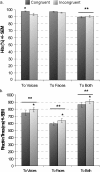Top-down and bottom-up modulation in processing bimodal face/voice stimuli
- PMID: 20222946
- PMCID: PMC2850913
- DOI: 10.1186/1471-2202-11-36
Top-down and bottom-up modulation in processing bimodal face/voice stimuli
Abstract
Background: Processing of multimodal information is a critical capacity of the human brain, with classic studies showing bimodal stimulation either facilitating or interfering in perceptual processing. Comparing activity to congruent and incongruent bimodal stimuli can reveal sensory dominance in particular cognitive tasks.
Results: We investigated audiovisual interactions driven by stimulus properties (bottom-up influences) or by task (top-down influences) on congruent and incongruent simultaneously presented faces and voices while ERPs were recorded. Subjects performed gender categorisation, directing attention either to faces or to voices and also judged whether the face/voice stimuli were congruent in terms of gender. Behaviourally, the unattended modality affected processing in the attended modality: the disruption was greater for attended voices. ERPs revealed top-down modulations of early brain processing (30-100 ms) over unisensory cortices. No effects were found on N170 or VPP, but from 180-230 ms larger right frontal activity was seen for incongruent than congruent stimuli.
Conclusions: Our data demonstrates that in a gender categorisation task the processing of faces dominate over the processing of voices. Brain activity showed different modulation by top-down and bottom-up information. Top-down influences modulated early brain activity whereas bottom-up interactions occurred relatively late.
Figures






Similar articles
-
Event-Related Potentials Reveal Evidence for Late Integration of Emotional Prosody and Facial Expression in Dynamic Stimuli: An ERP Study.Multisens Res. 2019 Jan 1;32(6):473-497. doi: 10.1163/22134808-20191332. Multisens Res. 2019. PMID: 31085752
-
Neural correlates of perceptual narrowing in cross-species face-voice matching.Dev Sci. 2012 Nov;15(6):830-9. doi: 10.1111/j.1467-7687.2012.01179.x. Epub 2012 Sep 7. Dev Sci. 2012. PMID: 23106737
-
Effects of congruent and incongruent visual cues on speech perception and brain activity in cochlear implant users.Brain Struct Funct. 2015 Mar;220(2):1109-25. doi: 10.1007/s00429-013-0704-6. Epub 2014 Jan 9. Brain Struct Funct. 2015. PMID: 24402676
-
The interactions of multisensory integration with endogenous and exogenous attention.Neurosci Biobehav Rev. 2016 Feb;61:208-24. doi: 10.1016/j.neubiorev.2015.11.002. Epub 2015 Nov 10. Neurosci Biobehav Rev. 2016. PMID: 26546734 Free PMC article. Review.
-
A unified coding strategy for processing faces and voices.Trends Cogn Sci. 2013 Jun;17(6):263-71. doi: 10.1016/j.tics.2013.04.004. Epub 2013 May 10. Trends Cogn Sci. 2013. PMID: 23664703 Free PMC article. Review.
Cited by
-
Impaired Multisensory Integration Predisposes the Elderly People to Fall: A Systematic Review.Front Neurosci. 2020 Apr 28;14:411. doi: 10.3389/fnins.2020.00411. eCollection 2020. Front Neurosci. 2020. PMID: 32410958 Free PMC article.
-
Frontoparietal Brain Network Plays a Crucial Role in Working Memory Capacity during Complex Cognitive Task.eNeuro. 2024 Aug 8;11(8):ENEURO.0394-23.2024. doi: 10.1523/ENEURO.0394-23.2024. Print 2024 Aug. eNeuro. 2024. PMID: 39029954 Free PMC article. Clinical Trial.
-
Coherent activity between auditory and visual modalities during the induction of peacefulness.Cogn Neurodyn. 2013 Aug;7(4):301-9. doi: 10.1007/s11571-012-9234-9. Epub 2012 Dec 21. Cogn Neurodyn. 2013. PMID: 24427206 Free PMC article.
-
Neural Correlates of Voice Learning with Distinctive and Non-Distinctive Faces.Brain Sci. 2023 Apr 7;13(4):637. doi: 10.3390/brainsci13040637. Brain Sci. 2023. PMID: 37190602 Free PMC article.
-
Enhancing allocation of visual attention with emotional cues presented in two sensory modalities.Behav Brain Funct. 2022 Sep 22;18(1):10. doi: 10.1186/s12993-022-00195-3. Behav Brain Funct. 2022. PMID: 36138461 Free PMC article.
References
-
- Bertelson P, Radeau M. Cross-modal bias and perceptual fusion with auditory-visual spatial discordance. Percept Psychophys. 1981;29(6):578–584. - PubMed
Publication types
MeSH terms
LinkOut - more resources
Full Text Sources

